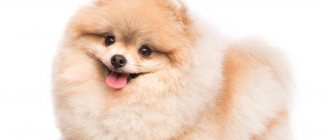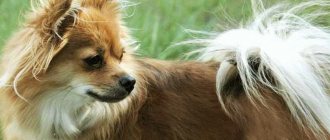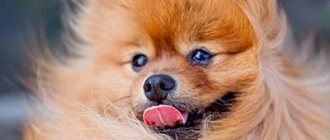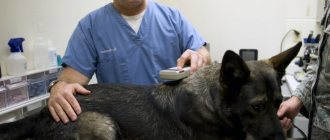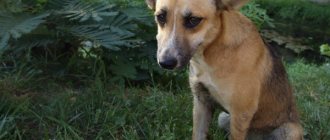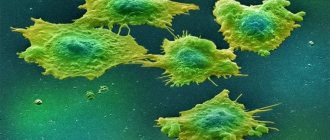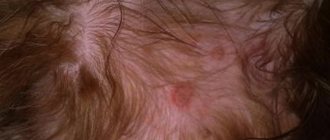A properly raised Pomeranian is wary of strangers. He doesn’t show aggression first, but he also won’t allow anyone to touch his luxurious fur coat. Without proper training, the dog will bark at every passerby on the street, and ring a bell at any rustle in the apartment. To avoid conflicts with neighbors, your pet’s behavior needs to be corrected from childhood.
Poms get along quite well with other dogs and cats, especially if they grew up with them, but they periodically strive for dominance. When a second dog appears in a house where an adult Spitz lives, the owner will have to make an effort to make friends with the pets. To do this, you need to pay no less attention to Pomeranz than before. Otherwise, the pet will begin to prove to the owner that he is still the boss in the house and will become aggressive towards the newcomer. Spitz dogs should not be kept together with small pets (birds, hamsters, rats, etc.). Like the Karelo-Finnish husky, doggies have a very strongly developed hunting instinct.
Command training
Training and attitude towards it
The first step should not be training, but raising the pet. You need to teach your baby the rules of behavior in a new home from the first days.
All family members will have to show firmness. Fluffy puppies are very stubborn, they will quickly figure out the “weak link”, begin to manipulate, and set their own rules. The second important point is training in hygiene procedures.
Owners should be prepared for the fact that at first (up to about 6 months) the puppy will relieve itself in the apartment. Getting him used to walking will take time and patience. To begin with, you can lay out a diaper and sit your Spitz on it immediately after sleeping and eating. “Accidents” sometimes occur in adults as well. Due to the peculiarities of their physiology, it is difficult for Pomeranians to hold urine in a bladder for a long time, but well-mannered dogs know how to ask to go outside as needed.
When the little Pomeranian gets a little comfortable in the new place, you can begin to master the basic commands. Not only the comfortable coexistence of people and dogs, but, above all, the safety of the pet itself depends on the accuracy of their implementation.
It is recommended to study the commands in this order:
- “place”, “impossible”, “fu”;
- “to me”, “sit”;
- “lie down”, “stand”;
- “can”, “near”, “give”;
- “wait”, “voice”, “walk”, “fetch”.
In the case of the Pomeranian, it is very important to teach your pet the command “to be silent.”
Dogs are prone to barking for no reason. Babies usually receive the basics of upbringing in the breeder’s home; the owner’s task is to consolidate the acquired skills and continue the development of the Spitz. Pets have different abilities, but dogs master the full course of the listed commands (subject to daily exercise) by 6-7 months. A new order should begin to be learned only after the Spitz has fully mastered the previous one. There should be no breaks in classes, otherwise the child will forget some of the loose skills, and everything will have to start all over again.
Pomeranians are endowed with high intelligence and are quite trainable. The only thing that gets in the way is their stubbornness and desire to demonstrate independence. The main thing is not to make the mistake of mistaking Poms for stupid kids because of their touching appearance. Dogs must respect their owner and be aware of his dominant role. If you do not show strength of character, the Pomeranian will consider itself the “leader of the pack” and will not follow the orders of the owner.
You cannot hit or scold the dog! Representatives of this breed cannot tolerate rudeness or cruelty. In response, they show uncontrollability or aggression. You need to encourage your baby with a favorite treat or praise. Dogs love to be praised, they subtly sense the intonations of the human voice, strive to please their owner, and will be able to master not only basic commands, but also some circus tricks. In such an atmosphere, classes will be effective and will bring a lot of pleasure to both the owner and the dog.
The difference between a dog and a bitch
The main external and behavioral characteristics of the Pomeranian breed are inherent in individuals of both sexes, but there are still some differences between them. Thus, males are always the brighter representatives of the breed. Male poms are superior to females in appearance, have a more luxurious coat, and look better at shows. In addition, Spitz males shed less often and do not lose hair as much during seasonal shedding.
Males of this breed are more emotional and openly express their love and devotion to their owners. Males are less touchy, but more stubborn and cocky.
The main unpleasant aspects of keeping male Pomeranians are urine getting on the fur on the tummy and possible marks in the apartment. These points can be easily corrected by a suitable haircut, proper upbringing and timely walking of the pet. A properly cut Spitz does not have any unpleasant odors.
Another point is the “rut”. Even the most trained dog, having smelled a “dog wedding,” can become uncontrollable and run away from its owner.
Spitz females are very clean. Their long fur always looks neat, but they shed more. In addition to the seasonal change of hair, the female loses her undercoat before estrus, greatly “sheds” her hair after giving birth, then quickly grows back. During these periods, dogs require special care and enhanced nutrition.
By nature, Pomerantsev bitches are more cunning than males. They know how to find an approach to the strictest owner and know when to show tenderness. Females are more flexible and are not prone to escape.
Grooming
Usage
Most Spitz breeds have innate endurance and were bred for dog sledding , running long distances in harsh weather conditions.
These breeds require plenty of space to run and constant training. They tend to be excellent morning jogging partners, matching their owner's pace and running alongside them.
Spitz dogs need constant work and training.
Strong and resilient animals were used by nomadic peoples as draft power.
Herding breeds helped herd deer, cows and sheep.
watchdog qualities due to their developed sensory organs.
Most Laikas (related to Spitz) are universal dogs for hunting , but among them there are breeds of narrow specialization, for example, Norwegian Lundehunds are used for catching birds nesting in holes.
East Siberian Laika
Care and maintenance in the apartment
Let's now talk about how to properly care for a dog. Pomeranians are suitable for keeping in a city apartment or private house, but not on the street.
Miniature dogs are not intended for kennel (especially chain) life. Before the puppy arrives, you need to prepare a corner where the baby will feel safe.
The best option is a house made of fabric and padding polyester in which the dog will sleep. It should be placed in a part of the apartment that is protected from drafts and not too dark. It is better to install a “shelter” in the master bedroom so that the pet does not feel abandoned. You cannot take a puppy into your bed. Firstly, it is unsafe for the fragile Spitz. Secondly, it will be impossible to wean him off spending the night together.
In addition to the main house, you will need a bed, which will be located in the kitchen or in the room where the family spends time more often, because Pomeranians love to be with people. It is important to remember that little bullies prefer active games. To prevent him from using things that are absolutely not intended for this purpose for his fun, the baby must be provided with a sufficient number of rubber toys.
For walks you will need a collar or harness. Some owners consider a harness not the best choice, since the hair gets wiped out under the straps and bald patches form. However, if the dog runs around a lot outside, walks are frequent and short, you can buy a harness.
The collar should be leather or nylon, soft but durable. It must be tightened so that a human finger fits between the collar and the dog’s neck, otherwise the accessory will compress the dog’s airways.
A Spitz leash must be strong, thin and light in order to withstand an unexpected jerk if the pet suddenly wants to rush after a pigeon or cat. The optimal length is 5 meters. The dog will be able to move freely while remaining under control. Roulette is also a good option.
Muzzles for Pomeranians are usually made to order. Their faces are poorly suited for wearing such restraints. A muzzle will be required if the dog behaves aggressively, grabs passersby by the legs, or constantly picks up something from the ground.
Clothes for Poms, despite the presence of a thick undercoat, are also necessary. Overalls are needed not to insulate a pet, but to protect a chic fur coat from contamination in the off-season. A T-shirt, shirt or blanket will be needed during walks in the summer heat to protect the baby from overheating. Other elements (skirts, dresses, ties) are sometimes needed for participation in exhibitions. All things must be made from natural materials and fit freely on the dog.
At home, Pomeranz's clothes need to be taken off!
There is no great need for shoes - they are a fashionable element of a dog's wardrobe. If the baby categorically refuses to wear shoes, he should not be forced.
Hygiene
The main difficulty lies in caring for your pet’s luxurious coat. Pomeranians are less susceptible to matting than other long-haired breeds, but it is sometimes necessary to comb them out. A special tool will help you with this.
Combing wool
The procedure should be carried out three times a week, during the molting period - daily. For manipulation you will need a massage brush and a comb with long teeth. It is advisable to first spray the fur with a special spray to avoid splitting the ends of the hairs. Particularly carefully and correctly it is necessary to comb the groin, armpits, and areas behind the ears. Pomov's hypoallergenicity is a myth. Such dogs can provoke an allergic reaction in allergy sufferers, just like any other.
Bathing
Pomeranians should not be washed frequently. It is better to do this no more than once a month, only if it is heavily soiled. It is better to wash the baby with diluted shampoo for dogs of long-haired breeds; be sure to use conditioner.
A haircut
Do you need to cut your dog's hair? Certainly! This is the only way she will look beautiful and neat. To cut Pomeranians, buy thinning scissors. Usually the fur is trimmed slightly to maintain a neat appearance. When preparing for exhibitions, you need to round off the ears, shape the collar and “pants” - this is best left to a professional groomer. For hygiene purposes, you need to carefully trim the lint between your fingers and around the anus.
The machine cannot be used! This will disrupt the hair structure.
In addition to haircuts, when caring for Poms you need to:
Teeth cleaning
Brush your teeth with veterinary paste 2-4 times a week. This can be done with a soft brush or by wrapping your finger in a clean bandage. To prevent tartar from forming, it is good to buy special treats.
Nail trimming
Nails should be trimmed as needed using a nail clipper for toy breeds. Finish the edges with a nail file. The dog's paws should be washed after every walk, and vegetable oil should be rubbed into the pads - this will help prevent painful cracking.
Ear treatment
Pomeranian ears should be regularly inspected, cleaned with a special lotion to remove accumulations of sulfur and dust, and hairs should be plucked. For the procedure, use cotton pads; you cannot clean the ears with ear swabs; this method can cause serious injury to the dog.
Eyes
Now about why your eyes water so often. Due to their anatomical features, Pomeranians are prone to excessive tearing. It occurs more often during wind, dust storms, and hot weather. To eliminate the problem, you need to contact your veterinarian and ask to prescribe suitable eye drops.
It's better to have two bowls
Orange flowers
The orange tree, whose flowers are a charming white color, was quite popular in the Middle Ages. Many nationalities used them to decorate the bride's hair or decorate the wedding dress. They were a symbol of tenderness, purity, youth. Only in the middle of the twentieth century did the fashion for orange flowers begin to fade. Calla lilies and roses began to be used instead.
During the fashion for greenhouse plants, the orange tree was popular. It was specially planted in a large box so that it could be brought indoors during the cold season. The most famous bitter orange is the one planted by Charles III's wife Eleanor de Castille.
The delicate aroma, in which light notes of jasmine and honey are felt, has found its application in perfumery. Even today it is used to create perfumes. But relatively recently, during the Renaissance, only noble ladies could use this kind of perfume. This is due to the high cost of these fragrant flowers.
Light orange oil has been used by cooks in their work since ancient times. Pharmacists did not ignore him.
It was used to cure the plague. In the modern world of medicine, it is used to treat other ailments.
What to feed
The Pomeranian Spitz is suitable for both natural feeding and industrially produced food.
Breeders recommend the second option to novice dog breeders, since factory products are well-balanced in protein, fat and carbohydrate content, enriched with all the necessary vitamins and microelements, and the dog eats them well.
The best dog food is at least premium class. Economy-class goods, offered in large quantities by supermarkets, are dangerous to animal health. When choosing food, you need to carefully study its composition. In a good product, meat comes first in the list of ingredients (accounting for at least 30%). You also need to check the presence of vitamins and minerals in the list.
You should refuse to purchase food if it contains:
- offal;
- cellulose;
- sugar;
- nutshell;
- caramel;
- chemical preservatives, flavorings.
Pomeranians are well suited for food brands such as:
- Now Natural Holistic;
- Purina Pro Plan;
- Hills;
- Royal Canin;
- Optima Nova.
If the owner decides to cook for the dog himself, he will have to maintain the optimal ratio of the main elements. Half of the total daily diet should be protein foods, 30% should be cereals, 20% should be vegetables.
The best meat products for Pomeranians are beef and veal. Sometimes they can be replaced with chicken or turkey. The meat should not be boiled, but pre-frozen in the freezer (at least 15 hours). This way you can get rid of helminths while preserving the maximum of nutrients. By-products should not be given to Spitz dogs often - they can cause stomach upset in dogs.
In addition to meat, the diet should contain:
- buckwheat grain;
- vegetables. It is better to give them raw, grated;
- cottage cheese;
- rice;
- fruits;
- oatmeal;
- eggs (a couple of times a week). The product must be administered carefully, first give the dog the yolk, then the white. If no allergic reaction occurs, eggs can be given whole, boiled or raw;
- sea fish, boned;
- kefir, yogurt. Adults do not need to be given milk. It is not absorbed by the body.
What you should not feed your Pomeranian:
- fatty meat;
- onions;
- legumes;
- beets;
- grapes;
- smoked meats;
- baked goods;
- mushrooms;
- persimmon;
- sweets;
- potatoes;
- tubular bones;
- garlic;
- raisins;
- fresh bread;
- sausages.
Vitamin supplements can only be given to dogs as prescribed by a veterinarian!
The combined type of feeding for Poms is not recommended - the stomach of these dogs does not react well to frequent changes in food. An adult dog should eat twice a day in approximately equal portions, and constant access to clean water is required. And of course you will need at least two bowls for food and drink.
Read about the nutrition of older dogs in a special article.
The best option would be to purchase a special automatic dog feeder that will feed your pet strictly on an hourly basis, even in your absence. It is also recommended to add a water fountain so that the dog is provided with filtered, oxygenated water.
Dry food contains everything you need for growth
Table of height and weight by month
Now about how much a Pomeranian Spitz should weigh. The development of different lines may differ significantly. Thus, some individuals reach the weight and height of adult dogs by 4 months, while in others this process is completed by nine months.
On average, it is believed that the period of intensive growth of Pomeranians ends at six months of age; they continue to gain body weight for some time. In a bitch, development may stop completely or temporarily during the first heat. Full physical development of representatives of this breed is completed by 2-3 years.
The rate of growth and weight gain of a puppy is influenced by various factors: heredity, diseases suffered at an early age, level of activity, approach to breeding dogs.
Some unscrupulous “breeders” deliberately underfeed puppies in order to pass them off as a dwarf variety and sell them at a higher price! Subsequently, such malnutrition will inevitably have a negative impact on the pet’s health.
The organization of nutrition by the owner himself has a huge impact on the full development of Poma. At first, it is better to feed the puppy what he ate at the breeder's house (you can ask for some food). Then, gradually, the baby can be transferred to the type of food preferred by the new owner.
This should be done gradually, adding one new product every 3-4 days, and observing the puppy’s reaction to unfamiliar food. Dry food should be selected according to the age of the Spitz. Giving your puppy food for adult dogs is prohibited!
The number of meals changes as the pet gets older:
- up to 2 months the puppy eats 6 times a day;
- from 2 to 3 months - 5;
- from 3 to 6 months - 4;
- from 6 to 8 months - 3 times a day.
After eight months, Pomeranz is gradually transferred to a two-time feeding regimen. Food should be given out at the same time, adjusting the portion size. This can be done by observing the baby. When he greedily licks an empty bowl, the amount of food should be increased; if there is food left in the cup, it should be reduced.
One of the indicators of the correct development of Pomerantz is his weight. You can estimate body weight by the type of pet:
- when the ribs can be clearly felt, there is practically no fat layer, the Spitz is underweight;
- if the ribs cannot be felt and are covered with a thick layer of fat, the baby becomes obese;
- with normal weight, the ribs can be felt, but the pits between them are insignificant, the layer is dense and of normal thickness.
To fully assess your pet's condition, it is necessary to weigh it regularly. We present the norms for weight gain by Pomeranian Spitz in the form of a table.
| Pomeranian age by month | weight depending on subtype (g) | ||
| standard | mini | dwarf | |
| At birth | 130-140 | 105-125 | 70-95 |
| 1 month | 460-490 | 325-370 | 210-275 |
| 2 months | 680-770 | 550-620 | 320-460 |
| 3 months | 1000-1150 | 800-920 | 460-690 |
| 4 months | 1300-1450 | 1000-1175 | 600-880 |
| 5 months | 1550-1700 | 1200-1350 | 700-1030 |
| 6 months | 1700-1900 | 1300-1500 | 770-1150 |
| 1 year | 2100-2300 | 1700-1900 | 1000-1400 |
Minor (5-10%) deviations from the norm are not a cause for serious concern if the baby is playful, eats well, and looks harmonious. Perhaps the dog has a light frame or is not growing evenly, over time it will “catch up” with its brothers. Underweight of more than 10% of the norm is a reason to contact a veterinarian. Most likely you will have to increase the calorie content of food or physical activity. If the cause of your Spitz's slow development is a previous illness or mistakes in breeding, serious treatment may be required.
Breed cost
How much does a Pomeranian cost? The price for purchasing a puppy of this breed varies depending on the family in which the puppy was born, meaning the pedigree of the parents. In the case where the mother and father of the Spitz have an excellent pedigree and have participated in various exhibitions and competitions, then such a dog costs from 50 to 100
thousand rubles.
If the puppy’s parents are more modest, you can buy such a Spitz for 25–50
thousand rubles.
In other cases, depending on luck, you will find a puppy for 15–20 thousand
rubles.
Advantages and disadvantages
When choosing a pet, it is important to take into account all the positive and negative qualities of a particular breed.
Among the main advantages of Pomeranians are:
- magnificent appearance;
- good learning ability;
- devotion to the owner;
- fairly good health (with the exception of dwarf individuals);
- cheerful disposition, energy;
- gets along well with children and other animals;
- suitable for keeping in a city apartment;
- They tolerate travel and changes of environment very well.
Cons of the Pomeranian:
- the high cost of the dog itself and its maintenance;
- requires serious education;
- needs long walks;
- complex grooming;
- stubbornness;
- tendency to bark for no reason;
- not suitable for outdoor living.
Pom shows its negative qualities only in the absence of proper care and education. You will have to do a lot of work with the dog; the owners will need patience and perseverance. Pomeranians are not suitable as a first dog.
Puppies are absolutely charming
Character and temperament
Small Pomeranians have a very affectionate, but at the same time restless disposition and good-natured character. Pomeranians have strong nerves, but at the same time they keenly sense the mood and emotions of their owner. Dogs love children very much and happily take part in joint games. They are also quite easy to train. They respond readily to the nickname and come running immediately. So many positive moments at once!
Despite the decorative nature of the breed, these dogs have all the signs of a real guard dog. The dog is extremely loyal and attached to its owner, ready to protect him in any danger. The breed has a strong-willed character. If someone stranger comes to the house, she will definitely inform about it with a ringing bark.
This breed leads an active lifestyle. Outdoor games and frequent walks are required to tone and maintain muscle mass. The Pomeranian will become a faithful companion and fill even the most stormy day with warmth.
Mating, pregnancy, childbirth
The Pomeranian's first heat occurs between 8 and 12 months. It is impossible to knit a girl at this age, since the body is not yet fully formed.
Early pregnancy and childbirth are dangerous for the health of the pet and can result in the birth of non-viable offspring.
It is recommended to cross a Pomeranian bitch for the first time at about two years of age (on her third heat). The same rules apply to male dogs.
Spitz females can become pregnant after each heat, but this should not be allowed more than once every 1-1.5 years. Childbirth and breastfeeding exhaust the bitch's body and she needs time to fully recover.
A pair for mating is selected through a club or nursery. It is important that both dogs have a full package of documents, undergo the necessary tests for the presence of genetic diseases, vaccination and deworming procedures.
Female Pomeranians weighing less than 2 kg are excluded from breeding.
Pregnancy in the Pomeranian Spitz lasts from 58 to 64 days. Some individuals give birth on day 67 - this is also considered the norm. Puppies born before day 57 usually die. If labor does not occur longer than 70 days after mating, you need to contact a veterinarian - the pregnancy may be frozen. You cannot give your pet stimulants on your own! Such actions can lead to injury and uterine rupture. Such medications are used only by a doctor.
You need to be well prepared for the birth of your babies. Organize a comfortable “nest” for the bitch in which she can safely give birth. It is desirable that it consist of two sections. In one there will be newborn babies, in the other - a giving birth bitch.
About 7 days before giving birth, the female’s stomach drops, the vagina increases in size, and the back sags. The day before the puppies appear, the Spitz's body temperature drops to 37 degrees. The bitch becomes nervous, loses her appetite, and does not leave her owner’s side. She needs to be reassured, not left alone, and shown an organized place to give birth.
The process itself is usually easy for Pomovs and does not require emergency assistance. The first baby, when born, causes pain to the mother, the bitch may begin to whine. Other puppies are born less painfully.
Newborn puppies “come out” in the placenta. More often the bitch chews it herself. If this does not happen, the dog will have to help: grab the bubble with a clean gauze, tear it near the puppy’s muzzle, and remove it. You need to hold the baby upside down, clear the mouth and nose of mucous secretions, and blow into the face. If the puppy squeaks and starts spinning, then everything is fine. The umbilical cord must be cut with sterile scissors three centimeters from the tummy. You cannot tie it in a knot.
Little Pomeranians are born 15 to 30 minutes apart. After giving birth, the bitch should be given water with a small amount of honey (but not sugar). If she asks for food, you can give her some kefir or cottage cheese. You also need to provide her with a tray to relieve herself. When a female asks to go outside, she should be carried out in her arms and not allowed to walk around much. The vagina, tummy and anus should be treated with a slightly pinkish solution of potassium permanganate.
Pomeranians usually give birth to 1 to 3 puppies. To make the babies larger, a female is chosen weighing about 2.5-3 kg, a male - 500 g less. When mating a large bitch with a much smaller male, 4-6 Spitz dogs may be born, but they will be small and of different sizes. It is impossible to predict litter size in advance.
While nursing puppies, it is necessary to transfer the bitch to a special feeding diet for nursing mothers so that she has a sufficient amount of milk. Only in this case can you count on healthy offspring. If there is still not enough milk, it is recommended to supplement with a bitch milk substitute.
Properties of bitter orange
It is no coincidence that the orange tree is so widespread and popular all over the world. It has many useful properties. These include:
- anti-inflammatory effect;
- use in the fight against rheumatism;
- calming properties used to treat depression, apathy, and depression;
- rejuvenating effect of fruits;
- helping to improve digestion and increase appetite;
- choleretic effect;
- positive effect on heart function.
Thanks to its antiseptic, antispasmodic and laxative properties, orange peel helps accelerate the treatment of colds and respiratory diseases. This fruit can relieve inflammation of the testicles in men. Orange seeds are a kind of antidote for poisonous bites of various types of insects and snakes.
How to choose a puppy, prices in Russia
A healthy Pomeranian puppy that meets all breed standards can only be purchased in a nursery or from a qualified breeder. People who breed responsibly do not sell Poms before 6-8 weeks.
It is better to pick up the baby in the house where he was born. This way, the potential owner will have the opportunity to see the conditions in which the puppies grew up and assess the condition of the mother and the entire litter.
There is no need to think about how much a puppy costs; first of all, the Spitz must be healthy. This can be determined by signs such as:
- no discharge from the eyes, nose or ears;
- tummy without bloating (this is a sign of infestation);
- the skin on the belly is not irritated, without rashes or redness;
- white teeth, correct bite;
- limbs are strong, straight;
- the fur is clean and shiny;
- a good appetite.
Little Pomeranians are playful, playful, curious, enjoy meeting new people, are not afraid of a hand sharply extended in their direction, and have a harmonious, proportional physique. The size of the baby should not be the determining factor in choosing a pet. Even a very small Pom puppy can grow quite large.
All Pomeranians change color slightly during hair growth (from 8 to 12 months). Lighter individuals become slightly darker and vice versa. Those who want to buy a pure white dog need to take a good look at the fur behind the ears; if a different shade is noticeable, the Pom will definitely not grow up completely white.
A purebred puppy always has a brand or chip, a veterinary passport with marks of the first vaccinations, a pedigree (or a puppy card). At the buyer's request, the breeder is obliged to provide documents from the dog's parents and test results for hereditary pathologies.
The price of a Pomeranian Spitz depends on the class to which the dog belongs:
Pat
A pet-class puppy can be purchased for 20,000 rubles. Such individuals are not suitable for breeding due to serious exterior defects, but they have all the physical and psychological characteristics of the Pomerantz. The kids will make excellent companions and pets. It is advisable to sterilize them at 6-10 months. This will help avoid accidental pregnancies and many health problems.
Breed
Breeding class puppies are sold for 30-50 thousand. These breed representatives most likely will not be stars of dog shows, since they have minor flaws in their appearance. However, they are included in the mating plan.
Show class
Show-class Spitz dogs, the offspring of elite parents, are the most expensive. Such a Pomeranian will cost the owner from 50,000 to 100,000 rubles.
Those who are not going to engage in breeding should not spend money on buying the most expensive dog, but there is also no need to buy a cheap Spitz from an ad on the Internet. Purebred dogs are not sold in this way; there is a high risk of buying a sick, non-viable individual.
Fruits and their uses
In the world, the orange tree is also called sour or bitter orange, Seville orange, bigaradia. Its peel consists of glycosides, organic acids, carbohydrates, and essential oils. The neroli type of essential oil of the fruit, consisting of camphene, myrcene, anthranilic acid methyl ester, limonene, geraniol, and linalool, has a fairly high price. Thanks to these components, it has wonderful aromatic and beneficial properties.
This fruit is not usually eaten fresh. But its unusual taste characteristics and aromatic properties have found wide application in cooking. In particular, they are used for making candied fruits, marmalade, and additives to a wide variety of sauces and drinks. All these processes involve only the skin of the fruit of the orange tree, which contains most of the beneficial and aromatic essential oil. Their pulp is not used.
Avicenna also used the fruits of this citrus tree. He devoted some of his works to describing their benefits.
How is it different from others
Spitz breeds are one of the oldest types of breeds. It has been established that such dogs are descendants of dogs that lived in the Stone Age. Therefore, traits similar to Pomeranians can be found in other, both related and unrelated groups. The common characteristics of such dogs are: magnificent fur and a fox-shaped muzzle. Let's take a closer look at several breeds that are sometimes mistaken for Spitz and tell you how to distinguish them.
Small German Spitz
Small German Spitz
Of course, it is extremely difficult to confuse him with a Grossspitz or a Mittelspitz due to the difference in size, although there are some similar features, but it is easy to confuse him with others.
Most often, the Pomeranian Spitz is confused with the Small German Spitz, but these are different breeds. “Germans” are the result of natural development. Their ancestors are considered to be the turf dog and the pile Spitz. The Pomeranian appeared as a result of artificial selection, the purpose of which was to make the individuals decorative.
The main emphasis was on appearance, while the German variety was used in economic activities, with guarding qualities, endurance, and good health of the dogs at the forefront.
Externally, the dogs are also somewhat different. The German Spitz is larger (up to 35 cm tall), has an elongated body, and a fox-like muzzle. In comparison with the more “square”, squat Pomeranians, “Germans” look graceful, and when moving they create the feeling of walking “on tiptoe”.
The ears of the German type dogs have a raised triangular shape, set vertically, the tail is fluffy, raised high, and wrapped in a ring. Their coat is straighter and coarser. Teeth are strong and healthy. While the Pomeranian species often does not have a full set of teeth.
Only one breed is officially registered in the FCI - the German Spitz, and the Pomeranian is considered its subspecies. In Russia, “Germans” are allowed to be crossed with “Pomeranians,” but with such mixed matings it is impossible to predict how tall the puppies in the litter will be.
Zwergspitz
Zwergspitz
These dogs are a dwarf variety of the Pomeranian. The standards of different international associations vary slightly.
Thus, FCI divides Pomeranian dogs into two types:
- small (Kleinspitz) - height 23-28 cm;
- miniature spitz - 18-22 cm at the withers.
One litter can contain puppies of both varieties. In character, miniatures are no different from their larger counterparts. They are brave, but not aggressive, and are distrustful of strangers. Provided proper selection, they have fairly good health. Some individuals live up to 22 years.
Italian Volpino
Italian Volpino
The breed is very similar in appearance to the Pomeranian. Its representatives have common ancestors with their Germanic counterparts. Unlike the latter, the “Italians” are slightly taller (25-30 cm). Only two colors are allowed: white and red.
Volpino Italiano is a fairly rare breed, but in recent years it has been gaining increasing popularity. Italian "foxes" are wonderful companions and guards, they have a cheerful, playful character. They are quite trainable, but can be quite stubborn.
Schipperke
Schipperke
Medium-sized, harmoniously built dogs, completely black in color, bred in Belgium, despite their sweet appearance, belong to the group of shepherd dogs and have all the qualities of shepherd breeds.
Schipperkes are hardy, tireless, and endowed with excellent guard qualities. They love children very much, they are devoted to the owner’s family members, but they are wary of strangers; if they sense danger, they may bite.
They are not recommended to be kept with small pets. Due to the developed hunting instinct, “shepherds” perceive rats or hamsters as prey.
Wolfspitz
Wolfspitz
This variety was originally called Keeshond. The breed was bred in the Netherlands, where its fairly large representatives (43-55 cm) were used for protection or hunting, since the dogs have an excellent sense of smell.
Later in Germany, Keeshonds were crossed with Spitz dogs, creating the Wolfspitz breed. The name of the dog is due to its wolf coloration. Their distinctive features are black ears, a mask, the tip of the tail and light “glasses” around the eye sockets. Wolfspitz dogs still retain their guarding qualities, but these working abilities need to be trained.
American Eskimo dog
American Eskimo dog
The breed is a direct descendant of the German Spitz. The height of “Eskimos” reaches 48 cm. The color is recognized exclusively as white, a light beige tint is acceptable.
The dogs are kind, playful, have an easy-going character, a cheerful disposition, and are completely devoid of aggression. This is one of the most obedient varieties of Spitz; “Americans” are perfectly trainable.
They perform brilliantly at various dog competitions and take part in circus performances.
American Eskimo dogs make good house watchdogs, but to do this they need to be trained and socialized in a timely manner to prevent the dog from becoming excessively timid.
Eurasier
Eurasier
Wolfspitz and Chow Chow were taken as the basis of the breed; later Samoyed blood was added to them. As a result, the dogs turned out to be of medium size (48-60 cm), strong build, athletic, and hardy.
Externally, Eurasiers are very similar to Pomeranians, but lack some negative character traits (for example, the desire to hunt). Any color of dogs is allowed, except for perfect white or brindle. The presence of large white spots is also considered defective.
Samoyed dog
Samoyed dog
The Samoyed dog is often mistaken for a huge Spitz, but the breed does not belong to this species. It is one of the oldest Aboriginal sled breeds. It was bred in Siberia and received its name from a similar name of one of the small nationalities.
From living in the Far North, Samoyeds have abundant, dense hair with a soft, thick undercoat and hard center hair. The color is recognized exclusively white, a slightly noticeable cream tint is possible. The eyes and nose should be black.
The dogs are quite large, the weight of an adult dog reaches 30 kg, the height at the withers is 46-56 cm (females are slightly smaller than males). The dogs' build is strong, their limbs are widely spaced.
By nature, Samoyeds are extremely sociable, agile, brave, but not aggressive, and easily adapt to new living conditions. They are friendly towards people and other animals. If there is an immediate threat, they can fight back, but the Samoyed dog will not make a guard. Despite its harmless appearance and good disposition, it is not recommended for novice dog breeders to own a Samoyed. They are stubborn, require a serious approach to education, and are prone to running away without sufficient physical exercise.
Description and breed standard
The Spitz is small in stature, but has a large body with protruding ribs and a powerful skeleton. The head, slightly reminiscent of a fox, has a rounded shape. Small, neat ears are not too widely spaced, and the muzzle is short. The nose is round, brown or black. The eyes are shiny, dark, almond-shaped. Planted close and not wide.
According to the description: the length of the body is approximately equal to its height. Therefore, the body is square in shape. The front legs are straight, widely spaced, rounded. The rear ones are straight. The tail is curled.
It is these dogs that can be visually identified by gender. The male is a little less handsome and graceful, but due to his power he reflects the stature of his species.
The Pomeranian Spitz stops growing by the age of six months. It measures 16–24 cm at the withers. Weight ranges from 1.4 (dwarf individuals) to 3.3 kilograms, the optimal weight for a Pomeranian is 2 kilograms, so in general, Spitz dogs are quite miniature.
Interesting Facts
Mozart's pet was the Pomeranian Spitz Bimperl, to whom the great composer dedicated a short sonata.
Three dogs were rescued from the sinking Titanic, including Elizabeth Barrett Rothschild's two Pomeranians.
Description of the Bedlington Terrier breed, its character and photos of various colors
In Europe and America, the cost of an adult Pomeranian of the doll or bear type reaches $10,000. In Russia, the difference in price in rubles is not so great.
Dogs of this breed often become heroes of films and literary works. The heroine of Anton Pavlovich Chekhov's story “The Lady with the Dog” was walking with the Spitz. Pom also starred in the TV series The X-Files.
What types of Pomeranian dog are there?
Pomeranians are divided into three types:
Fox type Spitz
The breed standard is considered to be a dog with an elongated muzzle, almond-shaped eyes, and a narrowed lower jaw.
Bear-type Spitz
Teddy bear Pomeranians have a spherical head, a short, flattened and wide face, with close-set round eyes.
Spitz type "baby doll"
All these three types differ from each other only in the shape of the head, otherwise they are absolutely the same.
